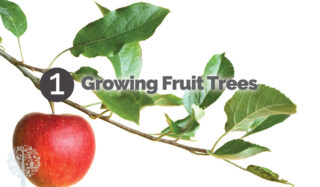Regenerative agriculture isn’t only for large acreages and countryside homesteads. Urban farmers and gardeners can be just as influential in the regenerative movement. Whether growing indoors, on a small patio, or with a community organisation, implementing regenerative gardening techniques is extremely rewarding. Urban gardening boosts food security by bringing nutritious produce closer to people. It helps reduce the heat island effect and removes carbon from the air. Avoiding pesticides and other chemicals is crucial, but regenerative growing is about so much more. Here are 5 Cool Ways to Practice Regenerative Growing in Cities.
Growing Fruit Trees
Many city dwellers assume their small space means they’re forever stuck buying tired-looking fruit from a supermarket, but that’s fake news. You can grow a fruit tree in a container as long as it is grafted onto dwarfing rootstock. Sally Morgan and Kim Stoddart, authors of The Climate Change Garden, admit that dwarf trees don’t live as long as bigger ones. But they produce fruit more quickly. Cherry, pear, plum, peach, nectarine, apricot, fig, and lemon trees all do well in containers on dwarf rootstocks. Stephanie Rose of Garden Therapy says growing espalier trees is another excellent option for smaller spaces. This method involves vertically training trees, shrubs, and groundcovers to create edible, living walls. Many espalier trees have four to six varieties grafted onto the branches to help with cross-pollination and better fruit production. Growing fruit in cities increases bio-diversity and food security, two cornerstones of regenerative agriculture. Bonus points for planting several different kinds of trees for diversity!

Planting Miyawaki Forests
While we’re on the subject of trees, we’ve got to talk about tiny forests, also known as micro-forests or little forests. In recent editions, Garden Culture has featured this trend because who doesn’t love regenerating ugly urban spaces? These forests consist of native trees and shrubs planted densely together following the Miyawaki method. Small-scale plantings are proven to reach climax forest status within ten years, decades sooner than traditional forests. Fine-tuned site preparation helps improve soil health, and the forest sequesters carbon, reduces the urban heat island effect and offers opportunities for communities to gather and enjoy time in nature. Several organisations offer grants or opportunities to get involved in mini-forest plantings. So, if you see a deserted concrete parking lot or under-used corner of a city park, get the ball rolling and propose regenerating the space with a Miyawaki forest!

Boosting Growth with Thermal Mass
Can concrete jungles actually be the place where dreams are made? If your dreams include maximising plant growth and regenerative techniques, then yes! Regenerative gardening is about more than building soil. In her book The Regenerative Garden, Stephanie Rose says it’s also about becoming familiar with unique microclimates and capturing, storing, and using naturally-produced energy. If there’s one thing cities have, it’s thermal mass. The first step is identifying structures that hold heat, like brick walls, concrete sidewalks, or fountains. Next, select some heat-loving plants and place them close by so they can take advantage of the warmth radiating from these structures. For example, thermal mass can make it possible for those living in cooler climates to grow citrus trees or Mediterranean gardens. Use recycled materials like bricks or stones to build herb spirals; these gardens last forever, save space in small yards, and give you a jumpstart on the growing season thanks to the extra heat they offer. Never underestimate the power of thermal mass in the garden!

Building Worm Hotels
Worm hotels are perfect for small spaces and produce the most beautiful black gold a plant could ever need. This easy DIY project involves digging a vermicompost bin into a raised bed or container garden. If you place a hotel in a pot, find some 6- to 8-inch PVC pipe about 18 inches long with a cap. Drill drainage holes in the bottom of the pipe, dig a hole in the soil about 15 inches deep and backfill around it. Add a couple of scoops of carbon sources, like dried leaves or shredded paper, and then some finished compost. Water everything down and add about 200 composting worms to the tunnel. Throw fruit and veggie scraps into the hotel and cover them with extra carbon so the worms can do their work. These hotels are easy enough to make, and you can add them to several containers or spots in your garden. The more the worms eat, the faster they reproduce. Once the hotel posts a no vacancy sign, divide the population, start a new bin, or share with your friends and neighbours. That’s the regenerative way!

Seed Sharing Libraries
Regenerative agriculture is all about using healthy soil and plants to heal the planet; the more people that grow, the better off we will be. Seed-sharing libraries are an excellent way to encourage others to take up gardening. These tiny wooden houses can be on your front lawn or in community spaces. They can include native seeds and seedlings, cuttings, gardening materials, tips and resources for other gardeners. If placed outdoors, ensure the seed library is waterproof and offers protection from the elements so the donations inside aren’t destroyed. Most importantly, Stephanie Rose recommends managing the box and engaging with community members so people feel connected and encouraged to share seeds from their gardens.

We recommend Stephanie Rose’s The Regenerative Garden to anyone looking for easy projects to implement in their growing spaces. The Climate Change Garden, by Sally Morgan and Kim Stoddart, is also excellent for gardeners looking to make a difference!